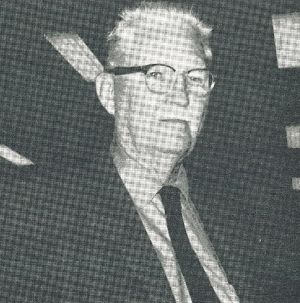
Mr William E Wunderlich was presented the first Hyacinth Control Society honorary lifetime membership during the 1967 meeting. The award and membership were presented in recognition of his many contributions and pioneering in the development of the field of aquatic vegetation control. He has perseveringly held fast to the objectives of proper and economical vegetation control through several transitions in the methods and philosophies of control. He has counseled countless individuals concerning their problems and most aquatic weed operations bear the evidence of his contributions to the field.
Bill Wunderlich is the son of a prominent former New Orleans physician. He was born in New Orleans on November 12, 1897. He entered the College of Technology at Tulane University in the fall of 1915 where he was registered as a student in Mechanical Engineering. In the summer of 1918 he enlisted in the United States Army and served until the cessation of hostilities. After leaving the Army, he engaged in various mechanical engineering activities and was especially active in such fields as piping systems, machinery of ships, saw mills, sugar mills, pulp and paper mills.
Bill joined the United States Corps of Engineers in 1929 for the specific purpose of designing and supervising the construction and operation of lock machinery. He was assigned the position of Chief of the Aquatic Growth Control Section of the New Orleans District in 1934.
At that time the principal method used to destroy the water hyacinth was by spraying with sodium arsenite. We recognize this process today as being extremely hazardous both to the operating personnel and to warm-blooded animals that might contact the spray solution. He has made extensive studies on the aquatic plants of the streams of Louisiana and developed techniques and special mechanical equipment for the control and destruction of aquatic plants.
The first equipment was designed to mechanically remove the water hyacinth from its water environment and place it on dry land. This was followed by equipment which was designed to crush the plant between heavy rollers and discharge the crushed material back into the stream in which the crushed plant floated. The latest mechanical device was the famous saw-boat. While working with these mechanical devices, Bill acted as a consultant to other districts on aquatic vegetation problems and furnished information on a world-wide basis to those who were interested.
Along with the development of safer herbicides in the 1940’s, he pioneered the use of 2,4-D for control of water hyacinth. This new approach to the problem demanded much innovation in the design of equipment and the development of a method of operations.
Mr Wunderlich plans to retire from the U. S. Army, Corps of Engineers, in the near future. He plans to remain active in the field of aquatic vegetation control.
Aquatic Plant Management Society
Copyright © 2024. All rights reserved.